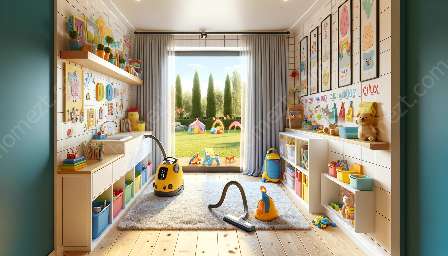Children's art and hobby spaces are often vibrant, creative environments where kids can unleash their imagination and express themselves through various activities. Whether it's a playroom, art corner, or craft area, maintaining cleanliness and organization is essential for creating a safe and inspiring atmosphere for kids.
In this comprehensive guide, we'll explore effective guidelines for cleaning children's art and hobby spaces, while also touching on the importance of maintaining cleanliness in children’s rooms and home cleansing techniques. By following these tips and techniques, you can ensure that your child's creative space is not only vibrant and inspiring but also safe and hygienic.
The Importance of Clean Children's Art and Hobby Spaces
Children's art and hobby spaces are often characterized by the presence of various art supplies, craft materials, and play items. While these elements foster creativity and play, they can also lead to clutter and the accumulation of dust, dirt, and other debris.
Furthermore, these spaces often serve as hubs for social interaction and creative exploration, making it even more crucial to maintain a clean and healthy environment. Cleanliness not only helps in preventing the spread of germs and bacteria but also ensures that children can fully engage in their creative pursuits without the risk of allergies or respiratory issues.
Guidelines for Cleaning Children's Art and Hobby Spaces
When it comes to cleaning children's art and hobby spaces, there are several guidelines and tips that can help you effectively maintain the cleanliness of these areas. These guidelines encompass various aspects, including organization, cleaning methods, and the use of child-friendly products:
- Organization: Encourage regular tidying up and organization of art supplies, craft materials, and toys. Use labeled containers and storage solutions to keep items neatly arranged and easily accessible. Teaching children the importance of tidying up after their activities can instill good habits and ensure that the space remains clutter-free.
- Cleaning Methods: Regularly vacuum or sweep the floors to remove dust, dirt, and debris. Wipe down surfaces, including tables, countertops, and storage units, with child-safe cleaning solutions. Pay attention to areas where art materials are used, such as easels, paintbrushes, and crafting stations, and clean these areas thoroughly to prevent the buildup of residues.
- Child-Friendly Products: When selecting cleaning products for children's art and hobby spaces, opt for non-toxic and environmentally friendly options. Look for cleaners that are safe for children and pets and avoid harsh chemicals that may pose risks to young ones.
Maintaining Cleanliness in Children’s Rooms
While focusing on the art and hobby spaces, it's equally important to maintain cleanliness in children’s rooms to create a holistic and hygienic living environment for kids. Here are some additional tips for keeping children’s rooms clean:
- Regular Decluttering: Encourage children to declutter their rooms by donating or discarding items they no longer use or need. This practice not only maintains cleanliness but also teaches kids the value of organizing and letting go of unnecessary items.
- Bedding and Linens: Wash and change bedding, blankets, and linens regularly to prevent dust mites and allergens from accumulating. Use hypoallergenic detergents and consider investing in allergen-proof pillow and mattress covers to promote better sleep and respiratory health.
- Air Circulation: Keep children’s rooms well-ventilated by opening windows or using air purifiers. Good air circulation helps reduce indoor pollutants and maintains a fresh, clean atmosphere.
Home Cleansing Techniques
Aside from focusing on children's art and hobby spaces and their rooms, implementing effective home cleansing techniques contributes to a healthier and more hygienic household. Here are some techniques to consider:
- Natural Cleaning Solutions: Explore the use of natural cleaning solutions such as vinegar, baking soda, and essential oils. These alternatives are not only safe for children and the environment but also effective in removing stains, odors, and dirt.
- Regular Deep Cleaning: Schedule regular deep cleaning sessions for the entire home, including children's play areas, bedrooms, and common spaces. Pay attention to overlooked areas such as baseboards, vents, and behind furniture to eliminate hidden dirt and allergens.
- Establishing Cleaning Routines: Implement cleaning routines that involve the whole family, emphasizing the importance of collective responsibility in maintaining a clean and healthy home environment. Assign age-appropriate cleaning tasks to children to cultivate a sense of ownership and teamwork.
Conclusion
Maintaining cleanliness in children's art and hobby spaces is crucial for providing a safe and nurturing environment for kids to explore their creativity and engage in play. By applying the guidelines for cleaning these spaces, along with focusing on cleanliness in children’s rooms and implementing effective home cleansing techniques, you can create a harmonious balance between creativity and cleanliness in the household.
Remember, a clean and organized environment not only promotes physical well-being but also nurtures a positive mindset and fosters a sense of responsibility in children. Embrace these guidelines and techniques to ensure that your child's art and hobby spaces are not only brimming with creativity but also pristine and hygienic.


